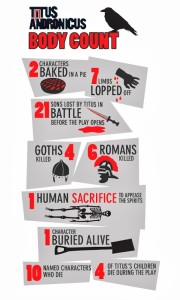Review: THE SPANISH TRAGEDY at the Marin Shakespeare Company
July 25, 2013 § Leave a Comment
A 425 Year-Old Debutante
For fans of Shakespeare and his contemporaries, the warmth of summer brings in the feasting season. Dessert this year is the Marin Shakespeare Company’s production of the rarely performed Thomas Kyd masterpiece, The Spanish Tragedy. (In fact, after 425 years it is said to be making its Northern California debut.)

Hieronimo, Knight-Marshal of Spain (Julian Lopez-Morillas) mourns for his murdered son Horatio (Erik Johnson) in Marin Shakespeare Company’s outdoor production of Thomas Kyd’s “The Spanish Tragedy.”
Photo by Eric Chazankin
The plot of Kyd’s revenge tragedy has more than a passing resemblance to Hamlet, a comparison from which it usually suffers but which also supplies it endless fascination. Although its date of composition is uncertain most scholars place it in the mid-to-late 1580s at just about the same time Shakespeare was probably starting his career in London. It is some dozen years older than Shakespeare’s Hamlet, a model therefore, and not a copy.
Spanish Tragedy opens with a ghost seeking revenge – accompanied in the play by a character named Revenge, in fact. It also features a doubting and delaying revenger who feigns madness to buy time, a woman driven genuinely mad by loss who eventually commits suicide, and a decisive play-within-a-play. Solely on the evidence of this resemblance, in fact, Kyd is believed to be the author of the mysterious ur-Hamlet, the now lost play on which Shakespeare is thought to have based his version.
The misfortune of the Spanish Tragedy is that through most of the twentieth century it was usually studied not because it is the progenitor of the revenge tragedies that dominated the Elizabethan stage, although it is, but as a less subtle comparator to Hamlet, useful for teleological arguments “proving” Shakespeare’s genius. Theater companies have had little incentive to produce it because the inevitable criticism is that it is nothing but a sensational oddity from the dustbins of history.
Body Counts and Comparisons
Among the things that becomes clear from watching the play in performance in Marin (from an edition prepared by the company’s skillful dramaturg, Mary Ann Koory) is that Hamlet is the wrong comparator. It is far more like Shakespeare’s first – and decidedly unsubtle – revenge tragedy, Titus Andronicus. It has a plotting Iago-ish Machiavellian character at its center, like Titus’ Aaron. The revenger is not a son, but a father, like Titus. A powerful woman drives the plot forward, like Tamora. Most of all, it is not structured around introspective monologues, but (exactly like Titus) around grisly and horrific violence – lots and lots of violence. If you are not familiar with Titus, the Royal Shakespeare Company has prepared a helpful graphic of the body count for its current production, attached here.

The Royal Shakespeare’s infographic of the Titus body count, to which Spanish Tragedy is a worthy rival.
Similarly, The Spanish Tragedy begins with a murdered minor nobleman, Don Andrea, tallying the deaths from a war in which, by the rules of chivalry, he would have been taken prisoner for ransom instead of killed. It proceeds through the onstage murder of a bound victim, two ambushes of unsuspecting co-conspirators to eliminate witnesses, a narrowly averted burning at the stake of an innocent man, an unexpected hanging of a guilty one who thought he had bribed his way to freedom, an offstage suicide, a final scene with so many deaths that it leaves the lines of succession of both Spain and Portugal destroyed, and the hero biting out his own tongue so he cannot be forced to confess!
Before “To be, or not to be” there was “Oh eyes, no eyes”
Titus, of course, was not held in high esteem until very recently, when it began to be judged by its own Senecan aesthetic aims instead of belittled for not being more like the late tragedies. Ironically, it was Shakespeare’s most successful play in his lifetime. It did not hold a candle to Spanish Tragedy, however, which was the most successful play of the entire period. It has more recorded performances and more references in plays, poems, and diaries than any play before the Commonwealth. What “To be or not to be” is to us now, the protagonist, Hieronimo’s, great speech “Oh eyes, no eyes, but fountains fraught with tears” was to the early modern audience then.
Julian Lopez-Morillas plays Hieronimo with a riveting intensity throughout, but his delivery of the famous monologue confirmed its still current fascination, as he used it to shift the action into a higher gear. His dark humor and grisly determination had the same kind of power that Antony Hopkins brought to Julia Taymor’s filmed Titus. In his hands we begin to see what all the fuss was about.
Few in the cast could keep pace with him, but Elena Wright was an intriguing (in both senses of the word) Bellimperia, the female lead around whom much of the plot turns. Female characters from the period generally do not have the agency and intensity that Bellimperia has, and Wright reveled in the chance to play her strength. Erik Johnson was a very charismatic Horatio, the young man in love with her, and the presumed revenger, until he is captured and casually murdered in front of her (and us) midway through the play. Scott Coopwood played Bellimperia’s father, a particularly complex role, notably.
It is carping to note that much of the rest of the very large cast was less experienced, since the economic reality is that is about the only way any company could afford to mount this show. The divide between the professionals and the others was wide, however, and both the pace and the verse speaking suffered often because of it. The production’s strengths were heavily invested in the protagonists, unbalancing the action when the antagonists were (at least theatrically) not their match. A surprising set of comic characters who seem to have wandered into the tragedy from Much Ado, however, helped to energize the second half.
Beautiful Executions
Set Designer Shannon Walsh created a beautiful and varied Spanish compound, but for some reason chose not to structure any visual relationship between the three sets of gallows for major executions that sub-divide the play into acts – often thought of as the main visual motif of the play. Costume Designer Abra Berman gave us authentic period appearances for the characters, especially effective in visually aiding the audience to keep track of the complex alliances and shifting locales.

The murder of Hieronomo’s only son, Horatio (played by Erik Johnson, pictured), sets off a chain of murderous events in Marin Shakespeare Company’s outdoor production of “The Spanish Tragedy.”
Photo by Eric Chazankin
“Where Words Prevail Not, Violence Prevails”
Only in the final moments of the play did the production completely rise to the occasion, bring home to message encapsulated by its most famous line. When it blossomed into its full potential, however, it was easy to see why the vicarious power fantasy of revenge, and the sensational violence, was as popular as it was. In much the way that Titus has been rehabilitated in the last half century after nearly three hundred years of dormancy, The Spanish Tragedy seems ripe for rediscovery. The combination of black humor and suppressed rage at state sponsored (or at least tolerated) injustice – of which poor Kyd as a victim when he was tortured and his health permanently destroyed as collateral damage in the campaign to ensnare Christopher Marlowe – was not a Victorian taste, but seems all too apropos these days. We can only thank and admire Marin Shakespeare Company for exploring this gem.

Leave a Reply